- Accueil
- Pages cachées
- 05 FEVRIER 2024 NEWS
05 FEVRIER 2024 NEWS
INSTITUT SUPERIEUR D'ANTHROPOLOGIE
INSTITUTE OF ANTHROPOLOGY
ONLINE COURSES / COURS A DISTANCE
INSCRIPTIONS OUVERTES
REGISTER NOW
GRECE – 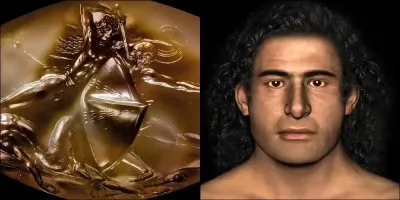 Pylos - In a remarkable new revelation, recent studies by the University of Cincinnati show that the Griffin Warrior was of Greek descent. The results, which the journal Science published, were part of a three-part study overseen by Harvard University, disputing previous claims that he was of outside origin.“When we look at the rise of the Mycenaean civilization, ancient DNA supports the notion that it was a local phenomenon, not something imported from the outside,” said co-author Jack Davis. It was the UC Classics professor and department head who, along with his wife Sharon Stocker in 2015, unearthed the Griffin Warrior’s tomb. Their findings were of great significance for historians, fellow archeologists, and geneticists alike. They helped clarify the migration patterns of people five to seven thousand years ago whose ancestry had intermingled when they joined Greece’s indigenous population. “This research addresses a bigger question,” Davis added. “Where do Greeks come from? We had no way of addressing that question without looking at genetic relationships.” It was the use of new scientific techniques that proved the Griffin Warrior’s Greek origins. This meant that migration patterns they had been studying had had very little impact on Greek society of that time. Research on the remains of the Griffin Warrior, as well as 726 others, confirmed that they were inhabitants of the region before and during the Bronze Age. Sharon Stocker, Davis’ wife, emphasized the Mycenaean King “carried no trace of steppe ancestry though dozens of both elite and humbler graves in Greece did.”
Pylos - In a remarkable new revelation, recent studies by the University of Cincinnati show that the Griffin Warrior was of Greek descent. The results, which the journal Science published, were part of a three-part study overseen by Harvard University, disputing previous claims that he was of outside origin.“When we look at the rise of the Mycenaean civilization, ancient DNA supports the notion that it was a local phenomenon, not something imported from the outside,” said co-author Jack Davis. It was the UC Classics professor and department head who, along with his wife Sharon Stocker in 2015, unearthed the Griffin Warrior’s tomb. Their findings were of great significance for historians, fellow archeologists, and geneticists alike. They helped clarify the migration patterns of people five to seven thousand years ago whose ancestry had intermingled when they joined Greece’s indigenous population. “This research addresses a bigger question,” Davis added. “Where do Greeks come from? We had no way of addressing that question without looking at genetic relationships.” It was the use of new scientific techniques that proved the Griffin Warrior’s Greek origins. This meant that migration patterns they had been studying had had very little impact on Greek society of that time. Research on the remains of the Griffin Warrior, as well as 726 others, confirmed that they were inhabitants of the region before and during the Bronze Age. Sharon Stocker, Davis’ wife, emphasized the Mycenaean King “carried no trace of steppe ancestry though dozens of both elite and humbler graves in Greece did.”
https://greekreporter.com/2024/02/01/ancient-dna-proves-griffin-warrior-greek/
PORTUGAL – 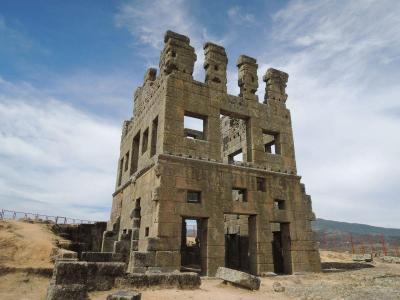 Belmonte - The Tower of Centum Cellas (also known as the “Tower of St. Cornelius”), located in the Mount of Santo Antão in Belmonte, Castelo Branco District, Portugal, is one of the most enigmatic monuments from the Roman period to be found in the country. These majestic ruins, built with large ashlar stones, were a Roman structure dating from the 1st century AD, situated on the road that linked Augusta Emerita (Mérida) to Bracara Augusta (Braga). The IPPAR‘s excavations (Portuguese Institute of Architectural Heritage) at the Centum Cellas Tower, undertaken between 1993 and 1998, revealed that it was not a single isolated building but part of a larger and more complex group of structures, including rooms, corridors, staircases, cellars, and courtyards. Made of pink granite blocks, this tower is rectangular and is about 39 feet (12 meters) high, appearing to have three levels with openings of various dimensions. Originally, the tower only had two floors. The tower’s upper story was added during the Middle Ages, it gives the tower a picturesque appearance. It also appears to have been surrounded by other adjacent structures that have since vanished and an entrance with pillars facing an open courtyard in the front. It was believed to have once been a temple, a jail with one hundred cells (thus the name), or perhaps a praetorium (the center of a Roman camp) and a structure that was a component of a Roman villa. There is evidence of extensive mining and processing in the Iberian Peninsula, which suggests that the tower was part of the facilities associated with tin mining and trade. The Iberian Peninsula was rich in minerals during the Roman era, especially tin. Archaeological excavations in the surrounding area in the 1990s revealed the remains of a villa rustica, of which pars urbana (main dwelling) the tower was a part. According to archaeological evidence, the tower was destroyed in the mid-third century by a great fire and was later rebuilt. The tower appears to be the best-preserved part of what was the villa of Lucius Caecilius (according to a dedicatory altar found on the site), a wealthy Roman citizen and tin trader who built his villa here at the beginning of the first century AD, under the supervision of a qualified architect who knew Vitruvius‘ building techniques.,The tower was refurbished for use as a watchtower in the 13th or 14th century, according to Pinho Leal, a Portuguese historian who lived in the 19th century.
Belmonte - The Tower of Centum Cellas (also known as the “Tower of St. Cornelius”), located in the Mount of Santo Antão in Belmonte, Castelo Branco District, Portugal, is one of the most enigmatic monuments from the Roman period to be found in the country. These majestic ruins, built with large ashlar stones, were a Roman structure dating from the 1st century AD, situated on the road that linked Augusta Emerita (Mérida) to Bracara Augusta (Braga). The IPPAR‘s excavations (Portuguese Institute of Architectural Heritage) at the Centum Cellas Tower, undertaken between 1993 and 1998, revealed that it was not a single isolated building but part of a larger and more complex group of structures, including rooms, corridors, staircases, cellars, and courtyards. Made of pink granite blocks, this tower is rectangular and is about 39 feet (12 meters) high, appearing to have three levels with openings of various dimensions. Originally, the tower only had two floors. The tower’s upper story was added during the Middle Ages, it gives the tower a picturesque appearance. It also appears to have been surrounded by other adjacent structures that have since vanished and an entrance with pillars facing an open courtyard in the front. It was believed to have once been a temple, a jail with one hundred cells (thus the name), or perhaps a praetorium (the center of a Roman camp) and a structure that was a component of a Roman villa. There is evidence of extensive mining and processing in the Iberian Peninsula, which suggests that the tower was part of the facilities associated with tin mining and trade. The Iberian Peninsula was rich in minerals during the Roman era, especially tin. Archaeological excavations in the surrounding area in the 1990s revealed the remains of a villa rustica, of which pars urbana (main dwelling) the tower was a part. According to archaeological evidence, the tower was destroyed in the mid-third century by a great fire and was later rebuilt. The tower appears to be the best-preserved part of what was the villa of Lucius Caecilius (according to a dedicatory altar found on the site), a wealthy Roman citizen and tin trader who built his villa here at the beginning of the first century AD, under the supervision of a qualified architect who knew Vitruvius‘ building techniques.,The tower was refurbished for use as a watchtower in the 13th or 14th century, according to Pinho Leal, a Portuguese historian who lived in the 19th century.
https://arkeonews.net/portugals-enigmatic-roman-building-tower-of-centum-cellas/
KENYA – 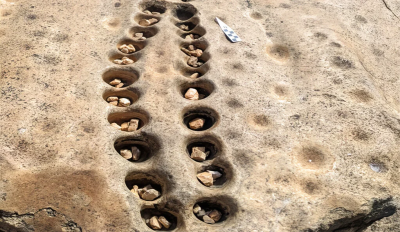 - Veronica Waweru, a Yale University archaeologist conducting fieldwork in Kenya, discovered an “arcade” of ancient Mancala game boards carved into rocks. Mancala stems from the Arabic word Naqala which means “to move.” In the game Mancala, users “sow” and “capture” seeds. According to historians, mancala may have been used as a divination tool, a harvesting ritual, or a record-keeping method at the beginning of civilization. Examples of this game have been found in Egyptian ruins dated from 1400 B.C.E. — carved into the temple roofs of Memphis, Thebes and Luxor. Even though the Mancala game dates back thousands of years, it is still widely played in the Middle East and Africa today. As per the Savannah African Art Museum, the earliest known mancala board was discovered at the Neolithic site of ʿAin Ghazal in Jordan and dates back to approximately 5870 ± 240 BC. Waweru noticed a series of shallow pits drilled into a rock ledge. A few of the pits were now pockmarks due to erosion. Others were sufficiently deep to support a handful of stones with ease. The pits’ differing degrees of erosion provided evidence that they were created at various points in time. This discovery led Waweru to theorize that ancient people used them to play a form of the game Mancala. Waweru said: “It’s a valley full of these game boards like an ancient arcade. Given the erosion of some of the boards, I believe that people were playing games there a very long time ago.” In all, the Kenya site includes about 20 of these Mancala boards. Some of the more recent examples are superimposed on their earlier counterparts. Also, the site contains 19 burial cairns built by herding communities that inhabited the region 5,000 years ago. The archaeologist thinks the two somehow may be connected in some way, given that the game boards share the site with 19 burial cairns. The precise age of the game boards is difficult to determine, she said, as they are carved into 400-million-year-old rock. DNA analysis of material found in the burial mounds could indicate how people interred in them relate to modern people, Waweru said. Waweru and her research team have applied for funding to continue studying the site, which is located near the equator in Kenya’s central highlands on the eastern side of the Great Rift Valley, which stretches from Lebanon in the Middle East to Mozambique in Southeast Africa.
- Veronica Waweru, a Yale University archaeologist conducting fieldwork in Kenya, discovered an “arcade” of ancient Mancala game boards carved into rocks. Mancala stems from the Arabic word Naqala which means “to move.” In the game Mancala, users “sow” and “capture” seeds. According to historians, mancala may have been used as a divination tool, a harvesting ritual, or a record-keeping method at the beginning of civilization. Examples of this game have been found in Egyptian ruins dated from 1400 B.C.E. — carved into the temple roofs of Memphis, Thebes and Luxor. Even though the Mancala game dates back thousands of years, it is still widely played in the Middle East and Africa today. As per the Savannah African Art Museum, the earliest known mancala board was discovered at the Neolithic site of ʿAin Ghazal in Jordan and dates back to approximately 5870 ± 240 BC. Waweru noticed a series of shallow pits drilled into a rock ledge. A few of the pits were now pockmarks due to erosion. Others were sufficiently deep to support a handful of stones with ease. The pits’ differing degrees of erosion provided evidence that they were created at various points in time. This discovery led Waweru to theorize that ancient people used them to play a form of the game Mancala. Waweru said: “It’s a valley full of these game boards like an ancient arcade. Given the erosion of some of the boards, I believe that people were playing games there a very long time ago.” In all, the Kenya site includes about 20 of these Mancala boards. Some of the more recent examples are superimposed on their earlier counterparts. Also, the site contains 19 burial cairns built by herding communities that inhabited the region 5,000 years ago. The archaeologist thinks the two somehow may be connected in some way, given that the game boards share the site with 19 burial cairns. The precise age of the game boards is difficult to determine, she said, as they are carved into 400-million-year-old rock. DNA analysis of material found in the burial mounds could indicate how people interred in them relate to modern people, Waweru said. Waweru and her research team have applied for funding to continue studying the site, which is located near the equator in Kenya’s central highlands on the eastern side of the Great Rift Valley, which stretches from Lebanon in the Middle East to Mozambique in Southeast Africa.
ANGLETERRE – 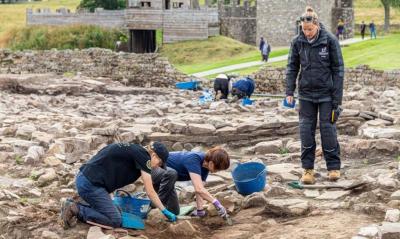 Vindolanda - Archaeologists working the Roman garrison site of Vindolanda in Northumberland, south of Hadrian’s Wall, have discovered new proof that the Romans also introduced Britain to bedbugs. Hygiene in ancient Rome included the famous public Roman baths, latrines, exfoliating cleansers, and public facilities, and is generally believed to have had high standards of cleanliness despite the use of communal toilet sponges. The arrival of the Romans in Britain and their hygiene probably influenced the inhabitants, but it seems that not everything was so perfect.Katie Wyse Jackson, 24, a student at University College Dublin (UCD), made the discovery while working on the excavated material for her master’s thesis in archaeoentomology, which is the study of insects at archaeological sites. Focusing on one of Vindolanda’s lowest layers, which dates back to around AD100, she discovered two thoraces thought to be from the common bedbug Cimex lectularius. Bedbugs are insects that feed on the blood of animals and humans. Dr Andrew Birley, who led the Vindolanda archaeological team, told the Guardian: “It is incredibly rare to find them in any ancient context.”Cimex lectularius or Bed bugs were mentioned in ancient Greek writings as early as 400 BC. Aristophanes, an ancient Greek playwright, wrote about bed bugs in several of his plays. Pliny, the ancient Roman philosopher, believed that bedbug bites could treat snakebites and ear infections. Dr. Stephen Davis, a UCD environmental archaeology lecturer, was part of the specialist team. He stated that there is one other Roman site in England where these have previously been discovered: Alcester in Warwickshire, but the Vindolanda ones are “the earliest found in Britain so far”. While analyzing soil samples, researchers also found insects that could provide more information. They stated that they could learn about trade, food storage, hygiene, and waste disposal from what species are present here and their numbers. “So we’re really not looking at a clean space here. Most importantly, a large proportion of the insects I’m finding are what we call synanthropic. They live in close proximity to humans. “The Romans do have that reputation as being extremely clean and so it’s interesting to find all of these insects that are contrary to that.”
Vindolanda - Archaeologists working the Roman garrison site of Vindolanda in Northumberland, south of Hadrian’s Wall, have discovered new proof that the Romans also introduced Britain to bedbugs. Hygiene in ancient Rome included the famous public Roman baths, latrines, exfoliating cleansers, and public facilities, and is generally believed to have had high standards of cleanliness despite the use of communal toilet sponges. The arrival of the Romans in Britain and their hygiene probably influenced the inhabitants, but it seems that not everything was so perfect.Katie Wyse Jackson, 24, a student at University College Dublin (UCD), made the discovery while working on the excavated material for her master’s thesis in archaeoentomology, which is the study of insects at archaeological sites. Focusing on one of Vindolanda’s lowest layers, which dates back to around AD100, she discovered two thoraces thought to be from the common bedbug Cimex lectularius. Bedbugs are insects that feed on the blood of animals and humans. Dr Andrew Birley, who led the Vindolanda archaeological team, told the Guardian: “It is incredibly rare to find them in any ancient context.”Cimex lectularius or Bed bugs were mentioned in ancient Greek writings as early as 400 BC. Aristophanes, an ancient Greek playwright, wrote about bed bugs in several of his plays. Pliny, the ancient Roman philosopher, believed that bedbug bites could treat snakebites and ear infections. Dr. Stephen Davis, a UCD environmental archaeology lecturer, was part of the specialist team. He stated that there is one other Roman site in England where these have previously been discovered: Alcester in Warwickshire, but the Vindolanda ones are “the earliest found in Britain so far”. While analyzing soil samples, researchers also found insects that could provide more information. They stated that they could learn about trade, food storage, hygiene, and waste disposal from what species are present here and their numbers. “So we’re really not looking at a clean space here. Most importantly, a large proportion of the insects I’m finding are what we call synanthropic. They live in close proximity to humans. “The Romans do have that reputation as being extremely clean and so it’s interesting to find all of these insects that are contrary to that.”
HONGRIE – 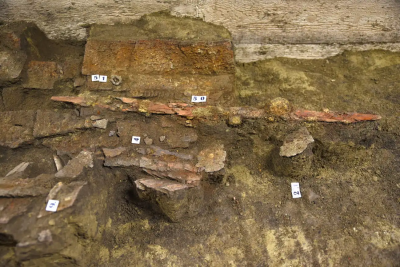 Ebes - Archaeologists of the Déri Museum in Debrecen (eastern Hungary) found the tomb of a fully armed and with a complete set of lamellar armor Avar warrior in November 2023 near Ebes (a village near Debrecen), the museum announced. The Avars arrived in Europe from the Central Asian steppes in the mid-sixth century CE and dominated much of Central and Eastern Europe for almost 250 years.Inside the Avar tomb from the 7th century AD, the warrior was buried next to his horse placed underneath. However, the most notable aspect of the find was the remains of the funerary equipment: a full complement of lamellar armor was found on the skeleton’s bones, along with a wooden quiver containing arrows, a sword, and a bow. It is one of the best-preserved Avar funerary sets found to date in the country. Its research will shed new light on the military gear and funeral customs of this nomadic people that migrated to the Pannonian Plain in the sixth and eighth centuries AD. The lamellar armor is only the second complete Avar funerary set in such a well-preserved state. The archaeologists were able to extract the entire set (excluding the horse bones) in a single block. Avar heavy cavalry carried lamellar armor as a vital piece of gear. This kind of armor is typically found in graves in small fragments, some of which have been stitched together. It is made up of hundreds of interlocking rectangular plates, and this type of armor was widely used in Eastern Europe and Asia.
Ebes - Archaeologists of the Déri Museum in Debrecen (eastern Hungary) found the tomb of a fully armed and with a complete set of lamellar armor Avar warrior in November 2023 near Ebes (a village near Debrecen), the museum announced. The Avars arrived in Europe from the Central Asian steppes in the mid-sixth century CE and dominated much of Central and Eastern Europe for almost 250 years.Inside the Avar tomb from the 7th century AD, the warrior was buried next to his horse placed underneath. However, the most notable aspect of the find was the remains of the funerary equipment: a full complement of lamellar armor was found on the skeleton’s bones, along with a wooden quiver containing arrows, a sword, and a bow. It is one of the best-preserved Avar funerary sets found to date in the country. Its research will shed new light on the military gear and funeral customs of this nomadic people that migrated to the Pannonian Plain in the sixth and eighth centuries AD. The lamellar armor is only the second complete Avar funerary set in such a well-preserved state. The archaeologists were able to extract the entire set (excluding the horse bones) in a single block. Avar heavy cavalry carried lamellar armor as a vital piece of gear. This kind of armor is typically found in graves in small fragments, some of which have been stitched together. It is made up of hundreds of interlocking rectangular plates, and this type of armor was widely used in Eastern Europe and Asia.
JAPON – 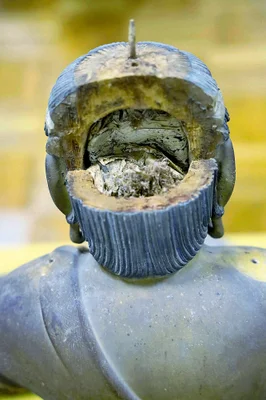
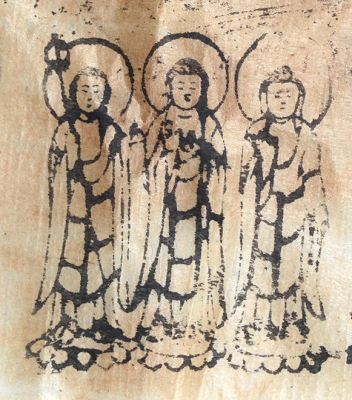 Fukuyama - The carved head of an ancient Buddhist statue hidden in the Myooin temple in Fukuyama, Hiroshima, Japan, has revealed pages of traditional “washi” paper decorated with images of the revered religious figure. Washi is a traditional Japanese paper. Washi paper has a history spanning over a millennium. It got worldwide recognition in 2014 when Washi paper was included among the oral and intangible heritages of humanity by UNESCO. It is known for being tear-resistant and translucent, with a pleasant texture. In Japanese culture, it was used for arts such as origami, shodō, calligraphy, and ukiyo-e. Myoo-in Temple has announced the results of an investigation into the paper found in the head of a Buddhist statue that is the principal image of the five-storied pagoda of Myoo-in Temple, a national treasure. The discovery followed the dismantling of the Maitreya statue, designated as an important cultural asset by Hiroshima Prefecture, for repair work. Three types of paper came out of the Buddha statue. Each piece of paper ink image has the three bodies of Shakyamuni Buddha, Yakushi Nyorai (Bhaisajyaguru), and Jizo Bosatsu (Kṣitigarbha). Images of the three figures made with seal stamps cover nearly every inch of space. One consists of ten sheets of washi, each measuring 23 centimeters by 16 centimeters and tied together with paper string. Each washi is distinguished by numerous stamps with ink images of Buddha, Bhaisajyaguru, and Ksitigarbha standing next to each other. Another consists of a stack of smaller sheets of paper imprinted with Buddhist images. The third was a single piece of paper with a Buddhist pattern and some characters on it. A representative from Fukuyama’s cultural promotion division stated that an ink image of Buddha frequently depicts a single figure that is stamped repeatedly. Three figures incorporated into a single seal at the same time is unusual. A representative of Fukuyama’s cultural promotion division noted “The three represent the three worlds of the past, the present, and the future,” he added. “We still have much research to do.” The Myoo-in Temple is said to have been founded in 807 by Kobo Daishi (774–835), also known as Kukai, a Japanese Buddhist monk, and calligrapher. Myooin’s five-storied pagoda (known as Jofukuji Temple until 1600) was built in 1384. Temple officials believe the seated statue was created around that time and delivered to Myooin to celebrate its completion in 1348. This raised expectations that the discovery would shed light on the circumstances surrounding the wooden pagoda’s construction 676 years ago.
Fukuyama - The carved head of an ancient Buddhist statue hidden in the Myooin temple in Fukuyama, Hiroshima, Japan, has revealed pages of traditional “washi” paper decorated with images of the revered religious figure. Washi is a traditional Japanese paper. Washi paper has a history spanning over a millennium. It got worldwide recognition in 2014 when Washi paper was included among the oral and intangible heritages of humanity by UNESCO. It is known for being tear-resistant and translucent, with a pleasant texture. In Japanese culture, it was used for arts such as origami, shodō, calligraphy, and ukiyo-e. Myoo-in Temple has announced the results of an investigation into the paper found in the head of a Buddhist statue that is the principal image of the five-storied pagoda of Myoo-in Temple, a national treasure. The discovery followed the dismantling of the Maitreya statue, designated as an important cultural asset by Hiroshima Prefecture, for repair work. Three types of paper came out of the Buddha statue. Each piece of paper ink image has the three bodies of Shakyamuni Buddha, Yakushi Nyorai (Bhaisajyaguru), and Jizo Bosatsu (Kṣitigarbha). Images of the three figures made with seal stamps cover nearly every inch of space. One consists of ten sheets of washi, each measuring 23 centimeters by 16 centimeters and tied together with paper string. Each washi is distinguished by numerous stamps with ink images of Buddha, Bhaisajyaguru, and Ksitigarbha standing next to each other. Another consists of a stack of smaller sheets of paper imprinted with Buddhist images. The third was a single piece of paper with a Buddhist pattern and some characters on it. A representative from Fukuyama’s cultural promotion division stated that an ink image of Buddha frequently depicts a single figure that is stamped repeatedly. Three figures incorporated into a single seal at the same time is unusual. A representative of Fukuyama’s cultural promotion division noted “The three represent the three worlds of the past, the present, and the future,” he added. “We still have much research to do.” The Myoo-in Temple is said to have been founded in 807 by Kobo Daishi (774–835), also known as Kukai, a Japanese Buddhist monk, and calligrapher. Myooin’s five-storied pagoda (known as Jofukuji Temple until 1600) was built in 1384. Temple officials believe the seated statue was created around that time and delivered to Myooin to celebrate its completion in 1348. This raised expectations that the discovery would shed light on the circumstances surrounding the wooden pagoda’s construction 676 years ago.
VIDEO = https://arkeonews.net/washi-papers-discovered-inside-a-675-year-old-buddhist-statue-in-japan/
ARABIE SAOUDITE – 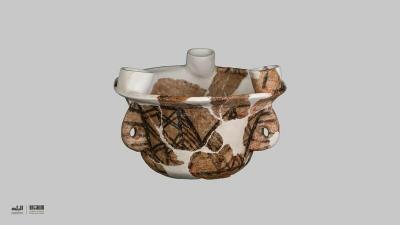 Jeddah - - Jeddah Historic District Program in cooperation with the Heritage Commission announced the discovery of 25.000 fragments of artifacts, the oldest of which dates from the first two centuries AH (from the 7th to the 8th centuries AD). The fieldwork was conducted on 4 different sites: Othman bin Affan Mosque (may Allah be pleased with him), Al-Shona, the Eastern Moat, and a segment of the Northern Wall. Archaeological survey and excavations, conducted in November 2020, resulted in the discovery of 11.405 pottery sherds which weigh 293 kg, 11.360 animal bones of 107 kg, 1.730 shells of 32 kg. In addition to 685 building materials which weigh 87 kg, as well as 187 glass artifacts which weigh 5kg and 71 metal artifacts of 7kg. Archaeological investigations in Othman bin Affan Mosque—may Allah be pleased with him—revealed the archeological discoveries. The oldest of which dates back to the first two centuries AH (from the 7th to the 8th centuries AD), passing through the early Islamic era, the Umayyad era, the Abbasid era, then the Mamluk era, and onto the modern times (i.e., the early 15th century AH / the 21st century AD). Further, analyses conducted on ebony pillars found on the sides of the Mihrab revealed that these pillars likely date back to the first two centuries AH (the 7th to the 8th centuries AD). The wood's origin has been identified to be Ceylon Island in the Indian Ocean which highlights the far-reaching trade connections of Historic Jeddah. In addition, the fragments of artifacts discovered in Othman bin Affan Mosque contain a variety of ceramic vessels and pieces of high-quality porcelain, among of which are some pieces made in the Chinese province of Jiangxi, that potentially date back to the 10th and 13th centuries AH (the 16th to 19th centuries AD), as well as some older pottery fragments dating back as far as the Abbasid era.,Meanwhile, at Al-Shona, the chronology of the site dates back at least to the 13th century AH (19th century AD) with indications of archaeological remains that could be as old as the 10th century AH (16th century AD). Numerous pottery sherds have been found at the site, comprising porcelain and other ceramics from Europe, Japan, and China, dating back to the 13th and the 14th centuries AH (the 19th to 20th centuries AD).Also, excavations at Al-Kidwah ("Bab Makkah" - Makkah gate) revealed parts of the Eastern Moat which most likely date back to the late 12th century AH (late 18th century AD).,Moreover, several tombstones of Mangabi stone, marble, and granite were also found in different locations in Historic Jeddah. The tombstones have inscriptions of names, epitaphs, and verses of the Quran which likely date back to the 2nd and 3rd centuries AH (8th and 9th centuries AD), and are still under thorough study by specialists.
Jeddah - - Jeddah Historic District Program in cooperation with the Heritage Commission announced the discovery of 25.000 fragments of artifacts, the oldest of which dates from the first two centuries AH (from the 7th to the 8th centuries AD). The fieldwork was conducted on 4 different sites: Othman bin Affan Mosque (may Allah be pleased with him), Al-Shona, the Eastern Moat, and a segment of the Northern Wall. Archaeological survey and excavations, conducted in November 2020, resulted in the discovery of 11.405 pottery sherds which weigh 293 kg, 11.360 animal bones of 107 kg, 1.730 shells of 32 kg. In addition to 685 building materials which weigh 87 kg, as well as 187 glass artifacts which weigh 5kg and 71 metal artifacts of 7kg. Archaeological investigations in Othman bin Affan Mosque—may Allah be pleased with him—revealed the archeological discoveries. The oldest of which dates back to the first two centuries AH (from the 7th to the 8th centuries AD), passing through the early Islamic era, the Umayyad era, the Abbasid era, then the Mamluk era, and onto the modern times (i.e., the early 15th century AH / the 21st century AD). Further, analyses conducted on ebony pillars found on the sides of the Mihrab revealed that these pillars likely date back to the first two centuries AH (the 7th to the 8th centuries AD). The wood's origin has been identified to be Ceylon Island in the Indian Ocean which highlights the far-reaching trade connections of Historic Jeddah. In addition, the fragments of artifacts discovered in Othman bin Affan Mosque contain a variety of ceramic vessels and pieces of high-quality porcelain, among of which are some pieces made in the Chinese province of Jiangxi, that potentially date back to the 10th and 13th centuries AH (the 16th to 19th centuries AD), as well as some older pottery fragments dating back as far as the Abbasid era.,Meanwhile, at Al-Shona, the chronology of the site dates back at least to the 13th century AH (19th century AD) with indications of archaeological remains that could be as old as the 10th century AH (16th century AD). Numerous pottery sherds have been found at the site, comprising porcelain and other ceramics from Europe, Japan, and China, dating back to the 13th and the 14th centuries AH (the 19th to 20th centuries AD).Also, excavations at Al-Kidwah ("Bab Makkah" - Makkah gate) revealed parts of the Eastern Moat which most likely date back to the late 12th century AH (late 18th century AD).,Moreover, several tombstones of Mangabi stone, marble, and granite were also found in different locations in Historic Jeddah. The tombstones have inscriptions of names, epitaphs, and verses of the Quran which likely date back to the 2nd and 3rd centuries AH (8th and 9th centuries AD), and are still under thorough study by specialists.
ALLEMAGNE – 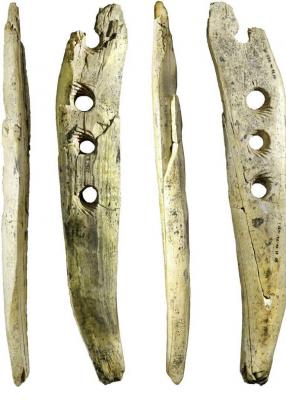 Hohle Fels Cave - A few years ago, archaeologists working in Hohle Fels Cave in southwestern Germany unearthed some mysterious ice-age objects. The team found 13 pieces of carved mammoth ivory that fit together to form what they described as a “perforated baton, with four holes containing precisely carved spiral grooves.” In a new paper, Conard and Rots argue that the 35,000-year-old ivory baton is a tool for making rope. Researchers were fairly sure that Paleolithic people used rope or twine, but the evidence was limited to depictions in art and a few impressions in clay. While evidence that ice-age people used rope was limited, there was no evidence illuminating how they manufactured it. Therefore the paper’s conclusion is a major breakthrough.The grooved holes were the key. “We suspected that the holes with spiral grooves were made to have something fed through them, which led us to hypothesize that the artifact may have served to align fibers to make rope or twine. While twine can be made by hand without tools, by pulling and twisting plant fibers together, we tested whether or not the perforated baton from Hohle Fels could have been used to align, twist, and combine fibers to make rope,” the paper explains.,Microscopic examination revealed fiber remnants around the grooves. Conard and Rots compared these fibers with sediment samples from around the artifact to rule out simple contamination from the environment. They found that the soil contained few plant fibers.,As a final test, Conard and Rots made a perforated baton of their own and tested it. Using the grooved holes they found that they could twist thick cords of up to four strands quickly and efficiently. They tested a few materials believed to be common during the period including deer sinew, flax, hemp, and others. They found cattail and willow fibers produced the best results.,“We are now able to demonstrate one way people of the early Upper Paleolithic manufactured rope. This work contributes to our understanding of the evolution of technology, cooperative work, and Paleolithic social organization,” the authors conclude.
Hohle Fels Cave - A few years ago, archaeologists working in Hohle Fels Cave in southwestern Germany unearthed some mysterious ice-age objects. The team found 13 pieces of carved mammoth ivory that fit together to form what they described as a “perforated baton, with four holes containing precisely carved spiral grooves.” In a new paper, Conard and Rots argue that the 35,000-year-old ivory baton is a tool for making rope. Researchers were fairly sure that Paleolithic people used rope or twine, but the evidence was limited to depictions in art and a few impressions in clay. While evidence that ice-age people used rope was limited, there was no evidence illuminating how they manufactured it. Therefore the paper’s conclusion is a major breakthrough.The grooved holes were the key. “We suspected that the holes with spiral grooves were made to have something fed through them, which led us to hypothesize that the artifact may have served to align fibers to make rope or twine. While twine can be made by hand without tools, by pulling and twisting plant fibers together, we tested whether or not the perforated baton from Hohle Fels could have been used to align, twist, and combine fibers to make rope,” the paper explains.,Microscopic examination revealed fiber remnants around the grooves. Conard and Rots compared these fibers with sediment samples from around the artifact to rule out simple contamination from the environment. They found that the soil contained few plant fibers.,As a final test, Conard and Rots made a perforated baton of their own and tested it. Using the grooved holes they found that they could twist thick cords of up to four strands quickly and efficiently. They tested a few materials believed to be common during the period including deer sinew, flax, hemp, and others. They found cattail and willow fibers produced the best results.,“We are now able to demonstrate one way people of the early Upper Paleolithic manufactured rope. This work contributes to our understanding of the evolution of technology, cooperative work, and Paleolithic social organization,” the authors conclude.
https://explorersweb.com/purpose-of-mysertious-ice-age-tool-revealed/